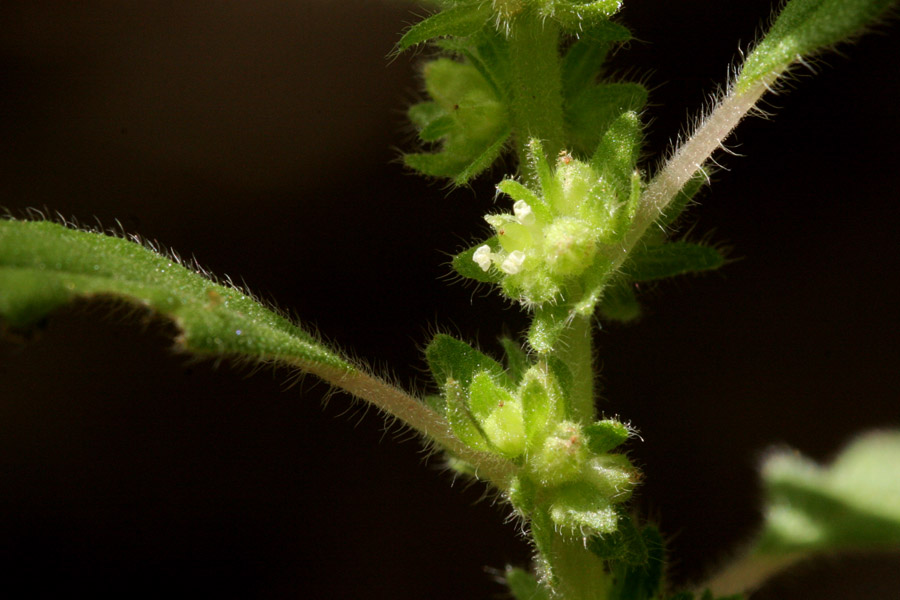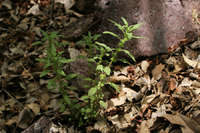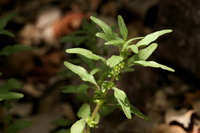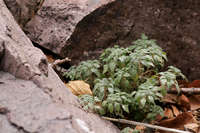Herbs , annual, 0.4-6 dm. Stems simple or freely branched, decumbent, ascending, or erect. Leaf blades narrowly to broadly elliptic, lanceolate, oblong, or ovate, (1-)2-9 × 0.4-3 cm, base narrowly cuneate, apex acuminate to long-attenuate or obtuse to rounded; proximal pair of lateral veins arising above junction of blade and petiole. Flowers: involucral bracts 1.8-5 mm, usually less than 2 times length of achene; tepals 1.5-2 mm, shorter than bracts. Achenes light brown, symmetric, 0.9-1.2 × 0.6-0.9 mm, apex obtuse, mucro apical; stipe straight, short-cylindric, centered, basally dilated. 2 n =14, 16.
Flowering spring-late fall. Dry ledges, talus slopes, waste and shaded places, primarily in neutral to basic soils, and reported from margins of hot springs in northernmost locations; 0-2400 m; Alta., B.C., Man., Ont., Que., Sask., Yukon; Ala., Ariz., Ark., Calif., Colo., Conn., D.C., Fla., Ga., Idaho, Ill., Ind., Iowa, Kans., Ky., La., Maine, Md., Mass., Mich., Minn., Miss., Mo., Mont., Nebr., Nev., N.H., N.J., N.Mex., N.Y., N.C., N.Dak., Ohio, Okla., Oreg., Pa., S.C., S.Dak., Tenn., Tex., Utah, Vt., Va., Wash., W.Va., Wis., Wyo.; Mexico.
Some extremes of Parietaria pensylvanica with short, oblong or ovate leaf blades strongly resemble P . hespera var. hespera . Parietaria hespera is usually more delicate and has thinner leaves with the proximal pair of lateral veins arising at the junction of blade and petiole. Leaf shape and texture tend to overlap in the two species, but in P . pensylvanica the proximal pair of lateral veins clearly arise above the junction of blade and petiole. The extremes of P . pensylvanica frequently are found where the ranges of the two species approach or overlap. Examples of these intermediates are from Gila, Mohave, and Yuma counties, Arizona. A mixed collection from Rock Springs, Gila County, Arizona, suggests that the two species occasionally grow together.
Plant: annual herb; 4-60 cm tall; Decumbent, ascending, or erect, simple or freely branched
Leaves: narrowly to broadly elliptic, lanceolate, oblong, or ovate, (0.8-)2-9 cm long, 0.4-3 cm wide, longer than wide; apex attenuate to long attenuate or obtuse to rounded; base cuneate
INFLORESCENCE: inglorescences of few flowered axillary cymes, the lowermost flowers usually perfect, those above pistillate
Flowers: subtended by bracts ca. 1.8-5 mm long; tepals ca. 1.5-2 mm long, the bracts exceeding the tepals
Fruit: achenes, symmetrical, 0.9-1.2 mm long, 0.6-0.9 mm broad, shining, hard and bony, ovoid, stipitate, enclosed by the perianth
Misc: Dry ledges, talus slopes, waste and shaded places, preferring soils with a neutral or basic reaction; to 2200 m (7200 ft); spring-late fall
REFERENCES: Boufford, David E. 1992. Urticaceae. Ariz.-Nev. Acad. Sci. 26(1)2.
Annual herb 4 cm - 0.6 m tall
Stem: decumbent to ascending or erect, unbranched to branched, with non-stinging hairs.
Leaves: alternate, stalked, 2 - 9 cm long, 0.4 - 3 cm wide, elliptic to lance-shaped or oblong to egg-shaped with a narrow wedge-shaped base and often pointed tip, non-toothed, having non-stinging hairs.
Flowers: borne on axillary inflorescences, the lower flowers bisexual or male and upper flowers female, subtended by a whorl of linear to lance-shaped bracts 1.8 - 5 mm long, with four tepals 1.5 - 2 mm long and four stamens.
Fruit: a smooth, shiny, light brown achene, 0.9 - 1.2 mm long, 0.6 - 0.9 mm wide, egg-shaped with a blunt or small abrupt tip.
Similar species: Pilea pumila and Pilea fontana have opposite leaves and are usually hairless. Laportea canadensis and Urtica dioica have both stiff, stinging hairs and flexible, non-stinging hairs. The flexible, non-stinging hairs of Boehmeria cylindrica are similar to those of Parietaria pensylvanica, but B. cylindrica can be distingished by its toothed, usually opposite leaves.
Flowering: mid May
Habitat and ecology: Shady areas lacking much competition, near buildings, along fences, under hedges, or bare areas under trees.
Occurence in the Chicago region: native
Etymology: Parietaria is the old Latin name of one species in the genus. It comes from the Latin word paries, meaning wall, referring to the original species' habitat. Pensylvanica means "from Pennsylvania."
Author: The Morton Arboretum
Infrequent to frequent throughout the state. It is usually found in colonies in dry soil in all kinds of woodland but prefers a sandy soil and is often found in large colonies in mucky or peaty areas that have been drained.
Duration: Annual
Nativity: Native
Lifeform: Forb/Herb
General: Erect, slender stemmed annual 10-40 cm tall, simple or sparingly branched at base, glabrate or more commonly sparsely to moderately villous with weak, white hairs.
Leaves: Lanceolate to lance-oblong, cuneate to slightly rounded at base, acute to acuminate at the apex, puberulent to villosulous, blades 5-12 mm wide, 2.5-7.5 cm long long slender petioles about one half as long as blade.
Flowers: In glomerules in most axils, bracts linear or lance-linear, 4-6 mm long, sparsely pubescent, sepals lance-linear, about 2 mm long, acute.
Fruits: Achenes, brownish about 2 mm long.
Ecology: Found along watercourses, in the shade of trees, cliffs, and rocks from 1,500-4,500 ft (457-1372 m); flowers March-June.
Notes: This plant is common through temperate North America.
Ethnobotany: Unknown
Etymology: Parietaria comes form Latin parietarius, of walls which details the preferred habitat, while pensylvanica comes from its being of Pennsylvania.
Synonyms: Parietaria obtusa, P. occidentalis, P. pensylvanica var. obtusa
Editor: SBuckley, 2010
Pubescent annual, erect or ascending, 1-4 dm; lvs petioled, thin, lanceolate, 3-8 cm, acuminate, entire, 3-nerved from above the cuneate base, obscurely scabrellate above; fls from the middle and upper axils; bracts lance-linear, 5 mm; achenes smooth, shining, ovoid, 1 mm, somewhat 2-edged; 2n=14. Dry woods and moist banks, sometimes weedy; Me. to B.C., s. to Va., Ala., Tex., and Nev. June-Sept.
Gleason, Henry A. & Cronquist, Arthur J. 1991. Manual of vascular plants of northeastern United States and adjacent Canada. lxxv + 910 pp.
©The New York Botanical Garden. All rights reserved. Used by permission.








